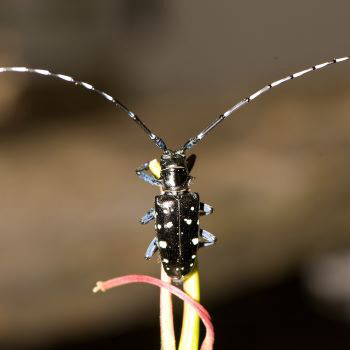

|
August is Tree Check Month
Michigan’s Invasive Species Program is joining with the U.S. Department of Agriculture’s Animal and Plant Health Inspection Service in asking the public to look for and report signs of the invasive Asian longhorned beetle.
Each year, APHIS declares August as Tree Check Month because this is the most likely time to see the beetle and the damage it causes to trees. Everyone can help look for signs of this destructive beetle by checking trees on their property and in their community for damage.
The Asian longhorned beetle, or ALB for short, is a non-native, wood-boring beetle considered invasive in North America because it attacks at least 12 types of hardwood trees, including maples, elms, horse chestnuts, birches and willows. There are no predators or diseases in North America to keep ALB populations in check.
In its larval stage, the insect feeds inside tree trunks and branches during the colder months. The beetle creates tunnels as it feeds, and then it chews its way out as an adult in the warmer months, creating large, round exit holes approximately 3/8 to 1/2-inch in size.
Why be concerned?
Infested trees do not recover and eventually die. They also can become safety hazards since branches can drop and trees can fall, especially during storms.
Isolated infestations in several states have caused the removal of thousands of trees in neighborhoods, parks and natural areas.
Although ALB has not yet been discovered in Michigan, it is crucial to look for any potential signs of its presence. Discovering early signs of infestation can prevent widespread damage to the state’s forest resources, urban landscapes and maple syrup production.
Look for signs
The adult beetle has markings that are easy to recognize:
Signs that a tree might be infested include:
Be aware of look-alikes
Several beetles and bugs native to Michigan often are mistaken for the Asian longhorned beetle, but there are differences to be aware of:
Report signs of ALB
If you think you found a beetle or tree damage, report it by calling the ALB hotline at 1-866-702-9938. Or submit an online report through the ALB web page. Try to photograph the beetle or tree damage. If you can, capture the beetle in a durable container and freeze it. This helps preserve the insect for identification.
Don't move firewood
ALB doesn’t move far on its own, but it can and has hitchhiked to new areas in untreated firewood. When traveling, leave firewood at home and purchase what you need locally or choose certified, heat-treated firewood to help prevent this destructive pest from showing up at your favorite places.
For more information about ALB, call the USDA at 1-866-702-9938 or visit APHIS.USDA.gov/Plant-Pests-Diseases/ALB.